Sunday, March 11, 2007
Sunday, March 04, 2007
Marylebone Meanderings - 3 March 2007
Marylebone is an interesting area of London: even the name is interesting, as everyone seems to pronounce it differently.  There are three official “correct BBC” pronunciations and a forth, used by London Underground when announcing the station on the Bakerloo Line. However you say it, the name derives from the name of the Parish Church, St Mary’s, which just happened to be near a river, or bourne – hence St Mary Bourne: became St Mary-le-bourne; became St Marylebone; became Marylebone. The river Tyburn has long since been culverted and appears only briefly as the lake in Regent’s Park
There are three official “correct BBC” pronunciations and a forth, used by London Underground when announcing the station on the Bakerloo Line. However you say it, the name derives from the name of the Parish Church, St Mary’s, which just happened to be near a river, or bourne – hence St Mary Bourne: became St Mary-le-bourne; became St Marylebone; became Marylebone. The river Tyburn has long since been culverted and appears only briefly as the lake in Regent’s Park




Property speculators developed the area in the 1700s and it retains a distinctive Georgian style.
 It is also home to 221b Baker St, a (then) fictitious address made famous by Arthur Conan Doyle in the Sherlock Holmes series. The address has now been given a physical location and is the home of the Sherlock Holmes Museum: a fascinating collection of memorabilia from the stories.
It is also home to 221b Baker St, a (then) fictitious address made famous by Arthur Conan Doyle in the Sherlock Holmes series. The address has now been given a physical location and is the home of the Sherlock Holmes Museum: a fascinating collection of memorabilia from the stories.
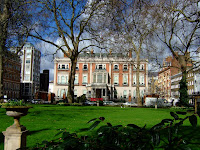 On our wanderings, we revisited one of our favourite Museums: Hertford House, home of the Wallace Collection. This remarkable collection, the work of the 3rd and 4th Marquises of Hertford, was gifted to the nation in 1897 with the unusual stipulation that nothing is ever added to or loaned from the collection.
On our wanderings, we revisited one of our favourite Museums: Hertford House, home of the Wallace Collection. This remarkable collection, the work of the 3rd and 4th Marquises of Hertford, was gifted to the nation in 1897 with the unusual stipulation that nothing is ever added to or loaned from the collection.
The day was rounded off in spectacular style as clear skies gave a magnificent view of a total lunar eclipse.

 There are three official “correct BBC” pronunciations and a forth, used by London Underground when announcing the station on the Bakerloo Line. However you say it, the name derives from the name of the Parish Church, St Mary’s, which just happened to be near a river, or bourne – hence St Mary Bourne: became St Mary-le-bourne; became St Marylebone; became Marylebone. The river Tyburn has long since been culverted and appears only briefly as the lake in Regent’s Park
There are three official “correct BBC” pronunciations and a forth, used by London Underground when announcing the station on the Bakerloo Line. However you say it, the name derives from the name of the Parish Church, St Mary’s, which just happened to be near a river, or bourne – hence St Mary Bourne: became St Mary-le-bourne; became St Marylebone; became Marylebone. The river Tyburn has long since been culverted and appears only briefly as the lake in Regent’s Park



Property speculators developed the area in the 1700s and it retains a distinctive Georgian style.
 It is also home to 221b Baker St, a (then) fictitious address made famous by Arthur Conan Doyle in the Sherlock Holmes series. The address has now been given a physical location and is the home of the Sherlock Holmes Museum: a fascinating collection of memorabilia from the stories.
It is also home to 221b Baker St, a (then) fictitious address made famous by Arthur Conan Doyle in the Sherlock Holmes series. The address has now been given a physical location and is the home of the Sherlock Holmes Museum: a fascinating collection of memorabilia from the stories. On our wanderings, we revisited one of our favourite Museums: Hertford House, home of the Wallace Collection. This remarkable collection, the work of the 3rd and 4th Marquises of Hertford, was gifted to the nation in 1897 with the unusual stipulation that nothing is ever added to or loaned from the collection.
On our wanderings, we revisited one of our favourite Museums: Hertford House, home of the Wallace Collection. This remarkable collection, the work of the 3rd and 4th Marquises of Hertford, was gifted to the nation in 1897 with the unusual stipulation that nothing is ever added to or loaned from the collection.The day was rounded off in spectacular style as clear skies gave a magnificent view of a total lunar eclipse.

Tuesday, February 27, 2007
Bye to Barcelona - 26 February 2007
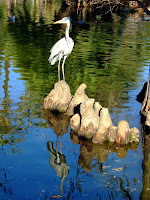 Our final day in Barcelona was a bit of a missed opportunity as we mis-read flight times and consequently arrived at the airport 2 hours before we needed to. We could have used the extra time in the afternoon to take a guided tour around the Palau de la Musica. Alas, we may never have that pleasure.
Our final day in Barcelona was a bit of a missed opportunity as we mis-read flight times and consequently arrived at the airport 2 hours before we needed to. We could have used the extra time in the afternoon to take a guided tour around the Palau de la Musica. Alas, we may never have that pleasure.Nevertheless, it was another cloudless day so we ventured over to the area of the city that was
 redeveloped for the 1992 Olympic Games. Nearby is a ‘village’ that was created as a show place for different Spanish architecture for the 1929 Universal Exposition. It is a tourist trap with many little artisans and craftsmen selling their wares direct from their workshops. It also includes a gallery of modern art, so we could tick off a bit of culture and admire the works by Picasso and others.
redeveloped for the 1992 Olympic Games. Nearby is a ‘village’ that was created as a show place for different Spanish architecture for the 1929 Universal Exposition. It is a tourist trap with many little artisans and craftsmen selling their wares direct from their workshops. It also includes a gallery of modern art, so we could tick off a bit of culture and admire the works by Picasso and others.
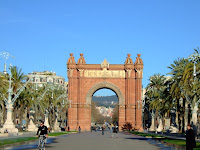
We wandered through the park close to the Hotel and looked at the Arc de Triomf and still had time to browse a couple of the markets and stroll La Rambla once again before we made our premature departure.
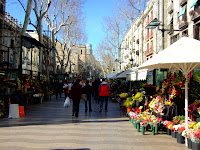

Back at Luton, we collected our car at 1 a.m. and found that attempts to access the M1 southbound at Junctions 10 and 9 were blocked by roadworks, with no prior warning signs and no suggestions as to alternatives. We wondered how a newly arrived traveller, having just collected a rental car would get on.
Gaudi gazing - 25 February 2007


Barcelona's most famous architect is Antoni Gaudi (1856-1926). It is
 reported that his Professor said that he did not know if he was awarding a degree to a genius or a lunatic. We made an early start to the day at Parc Guell, which is well towards the lunatic end of the spectrum, and ended with the unfinished Cathedral, which is sheer engineering brilliance.
reported that his Professor said that he did not know if he was awarding a degree to a genius or a lunatic. We made an early start to the day at Parc Guell, which is well towards the lunatic end of the spectrum, and ended with the unfinished Cathedral, which is sheer engineering brilliance.In between we visited an apartment building he designed and a building that he re-modeled, changing it extensively.
His work is full of ‘new’ ideas and concepts that he freely admitted he, with his keen sense of observation, stole from nature . Consequently the structures have a ‘flow’ and empathy to them that is not ‘natural’ in a building but is entirely ‘natural’.

Barcelona - 24 February 2007
 After a rushed start to catch an early morning train, which never arrived, we reached our hotel in Barcelona late morning. The Ciutat Hotel in the centre of the historic area, is an excellent base for exploring Barcelona.
After a rushed start to catch an early morning train, which never arrived, we reached our hotel in Barcelona late morning. The Ciutat Hotel in the centre of the historic area, is an excellent base for exploring Barcelona.The nearby Gothic area has the Cathedral amid a maze of narrow streets encircled by the old Roman wall.
We then wandered down La Rambla, the ‘place’ you have to go to stroll.
 It is lined with Street ‘statue’ artists, buskers, pickpockets and the traditional areas for selling art, birds and flowers. Such is the significance of the street that there are two words coined in its honour; an adjective (ramblista) to describe
It is lined with Street ‘statue’ artists, buskers, pickpockets and the traditional areas for selling art, birds and flowers. Such is the significance of the street that there are two words coined in its honour; an adjective (ramblista) to describe  those addicted to the act of the act of ramblejar (walking up and down La Rambla.)
those addicted to the act of the act of ramblejar (walking up and down La Rambla.)La Rambla finishes at the waterfront with a column topped by Columbus pointing meaningfully out to sea (in the direction of Italy!).
 From there we explored the new bridge to a shopping mall, and ended at La Barceloneta – the old fishing village. After lunch, we walked along the beach and back through La Barceloneta and the old city to our hotel: twisting and turning in a rather random fashion to explore the old streets.
From there we explored the new bridge to a shopping mall, and ended at La Barceloneta – the old fishing village. After lunch, we walked along the beach and back through La Barceloneta and the old city to our hotel: twisting and turning in a rather random fashion to explore the old streets.
Girona - 23 February 2007
 While in Morocco we met a gentleman from Gerona, as opposed to Two Gentlemen From Verona, and he highly recommended his hometown, especially the old city.
While in Morocco we met a gentleman from Gerona, as opposed to Two Gentlemen From Verona, and he highly recommended his hometown, especially the old city. As it happened, we were planning to visit Barcelona and the cheap airline we used, fly passengers destined for Barcelona into Girona airport (which is closer to France than Barcelona) so we decided to squeeze a day in Girona (as they spell it) into the schedule.
As it happened, we were planning to visit Barcelona and the cheap airline we used, fly passengers destined for Barcelona into Girona airport (which is closer to France than Barcelona) so we decided to squeeze a day in Girona (as they spell it) into the schedule. After flying in late at night and finally getting off to sleep in twin beds, we were awakened at 8am next morning by a concrete mixer, right outside our first-floor hotel room window. It wasn't possible to block it out, so we emerged to find a beautiful day. (The concrete mixer stopped soon after and did not appear to be used any other time of the day when we were near the hotel!)
After flying in late at night and finally getting off to sleep in twin beds, we were awakened at 8am next morning by a concrete mixer, right outside our first-floor hotel room window. It wasn't possible to block it out, so we emerged to find a beautiful day. (The concrete mixer stopped soon after and did not appear to be used any other time of the day when we were near the hotel!)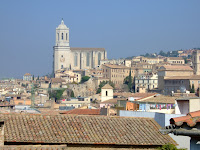 The most photographed sight in Girona is the old houses reflected in the river Onyar: they looked wonderful in the sunshine.
The most photographed sight in Girona is the old houses reflected in the river Onyar: they looked wonderful in the sunshine.We toured the Cathedral, which has the widest Gothic vault over the nave, the Arab baths, then walked along the extensive, restored, ancient city walls:
 a trip which provides wonderful views back over the multi-coloured tile roofs back to the Cathedral that dominates the skyline.
a trip which provides wonderful views back over the multi-coloured tile roofs back to the Cathedral that dominates the skyline.After a delicious salad at the River Café at the foot of the stairs to the Church of Saint Feliu, we started our afternoon wander around the old Jewish quarter, with its narrow winding streets and stairs, and on to a tour of the Monastery of Saint Pere de Galligants.
Tuesday, February 20, 2007
Flash flushing - 18 February 2007
 There are only two Grade 1 listed Industrial buildings in South London. One is a very well known, and much photographed, London icon (Tower Bridge) and the other is known to very few people, and given its location, seen and photographed by even fewer.
There are only two Grade 1 listed Industrial buildings in South London. One is a very well known, and much photographed, London icon (Tower Bridge) and the other is known to very few people, and given its location, seen and photographed by even fewer.We had booked a tour of the Crossness Pumping Station for Sunday afternoon. This was a magnificent Victorian achievement, commissioned after the
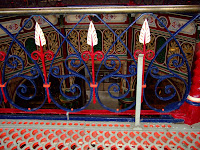 year of the ‘Great Stink' (1858) to deal with the problem of raw sewage in the Thames.
year of the ‘Great Stink' (1858) to deal with the problem of raw sewage in the Thames.It was designed on a large and impressive scale. Not only was the machinery impressive, the building to house the 4 huge pumps, was named the Cathedral in the Marsh.
 The Victorians surely knew how to get things done. The station was commissioned in 1865, just 7 years after the ‘stink’ and in only three years, 318 million bricks had been used to make 82 miles of intercept sewers to divert flows from discharging into the Thames and re-route the sewage downstream to Crossness on the
The Victorians surely knew how to get things done. The station was commissioned in 1865, just 7 years after the ‘stink’ and in only three years, 318 million bricks had been used to make 82 miles of intercept sewers to divert flows from discharging into the Thames and re-route the sewage downstream to Crossness on the  south bank and Abbey Mills on the north.
south bank and Abbey Mills on the north.There, these huge pumps each lifted 100 tonnes of effluent per hour into a reservoir where it was held until the tide began to ebb and the gates were opened to discharge the raw sewage into the Thames.
 Following its closure in 1956 it has lain abandoned and vandalized until restoration began in 1985. The restoration is a huge project, where you can see plenty of evidence of before and after and one that will keep the willing enthusiasts busy for years to come.
Following its closure in 1956 it has lain abandoned and vandalized until restoration began in 1985. The restoration is a huge project, where you can see plenty of evidence of before and after and one that will keep the willing enthusiasts busy for years to come. We intended to catch some of the Chinese New Year's celebrations both on the way in and way home, but managed to time it wrong both ways. However, we did enjoy the sense of humour displayed by the Metropolitan Police as they distributed hundreds of red balloons in honour of the Chinese year of the Pig.
We intended to catch some of the Chinese New Year's celebrations both on the way in and way home, but managed to time it wrong both ways. However, we did enjoy the sense of humour displayed by the Metropolitan Police as they distributed hundreds of red balloons in honour of the Chinese year of the Pig.
Subscribe to:
Comments (Atom)









